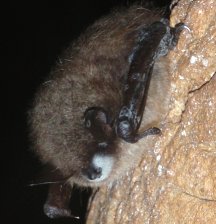
 Department of Conservation and Recreation
Department of Conservation and Recreation
Conserve. Protect. Enjoy.
 Department of Conservation and Recreation
Department of Conservation and Recreation
Natural Heritage karst staff and zoologists work together with the Virginia Department of Wildlife Resources, Virginia Department of Transportation, citizen volunteers, cavers, property owners, and scientists and students from Virginia's colleges and universities to study and protect Virginia's seventeen bat species. Our efforts include monitoring known bats populations and searching for undocumented populations both on the surface and subsurface, tracking movement of bats through space and time, implementation of protection projects such as cave gates, and promoting awareness of the value of bats and how to minimize impacts on them from human activity. Did you know, we even have a state bat, the Virginia Big-eared bat, designated in 2005.
Read and/or download our brochure about bats in Virginia.

Populations of many cave-dwelling bat species in Virginia have since 2009 been decimated by White-nose Syndrome(WNS), a disease caused by the pathogenic fungus Pseudogymnoascus destructans(Pd). More than ever, responsible cavers should avoid concentrations of hibernating bats since they may be the last hope for survival of several species. If concentrations of hibernating bats are observed, they should be reported to Wil.Orndorff@dcr.virginia.gov so that they can be tracked, and protected if necessary. Most importantly, cavers should never take clothing and equipment used in Virginia caves into caves in areas where WNS is not known, and should follow local decontamination protocols where they exist. Pseudogymnoascus destructans spores are likely present in all Virginia caves, and although the consensus is that bats were the primary vector spreading WNS, it is certainly reasonable that the disease could be spread as well by cavers via contaminated gear. For more on White-nose Syndrome, including distribution maps and decontamination protocols, please visit www.whitenosesyndrome.org.
Natural Heritage database search tool
(Go to Species/Communities Search tab - select mammals under the Taxonomic Group - then click the search button.)

